Welcome to the September 2019 issue of the Global Washington newsletter.
IN THIS ISSUE
- Letter from our Executive Director
- Issue Brief: How Microcredit Went from ‘Silver Bullet’ to Useful Tool in the Financial Services Toolkit
- Organization Profile: A Different Kind of Capitalism: Einstein Rising Lifts Up African Social Entrepreneurs
- Goalmaker: “The Advancer” Takes Impact to the Next Level
- From Our Blog: Microcredit Can Be a Life-Changer – But It Isn’t for Everyone
- Welcome New Members
- GlobalWA Member Events
- Career Center
- GlobalWA Events
Letter from our Executive Director
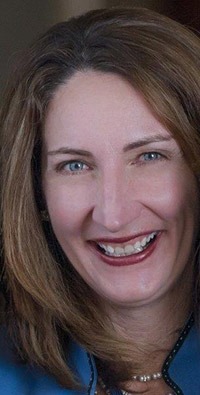
Access to finance is fundamental to increasing the quality of life of those living in poverty. Such access can create dignified work, make it possible for a business owner to expand her inventory, a parent to save for his child’s education, or a family to send money to a sick relative in another city. When people in poverty are excluded, we lose out on the creative potential of hundreds of millions of humans.
How people gain access to financial services, and what kinds of services they have available to them, is where I think things really get interesting.
I remember when I first heard about this thing called “microcredit” about 20 years ago. I was in graduate school and had the opportunity to go to Vietnam with three professors to research the impact of very small loans on local communities. The country was bursting with excitement about the potential to increase incomes with this approach for those living on a dollar a day. And, our research showed that there were effective programs to jump-start businesses and bring more women into the formal economy.
Some thought microcredit was the silver bullet to poverty reduction, however, it didn’t take long for practitioners to realize that it’s not that simple. No single intervention can propel sustained income growth for the poorest of the poor. Today the global development community has a better handle on how microcredit can be included in a broader set of approaches that include expanded financial services (savings, insurance, digital payments, and more), along with the increasing influence of social impact investment.
In this month’s newsletter you’ll read about a feisty new Global Washington member, Einstein Rising, that is redefining what it means to invest in African business leaders. You’ll also meet a daring Goalmaker at Capria, who is advancing triple-bottom-line corporate strategies, designed to be profitable and sustainable, as well as to benefit society broadly.
These are just a couple of the amazing stories we hear about every day in our community. If you are a Global Washington member who would like to tell your story live and reach new audiences, I encourage you to sign up for the Fast Pitch at our conference on November 15. We are now accepting applications.
I hope to see you there!

Kristen Dailey
Executive Director
Issue Brief
How Microcredit Went from ‘Silver Bullet’ to Useful Tool in the Financial Services Toolkit
By Joanne Lu
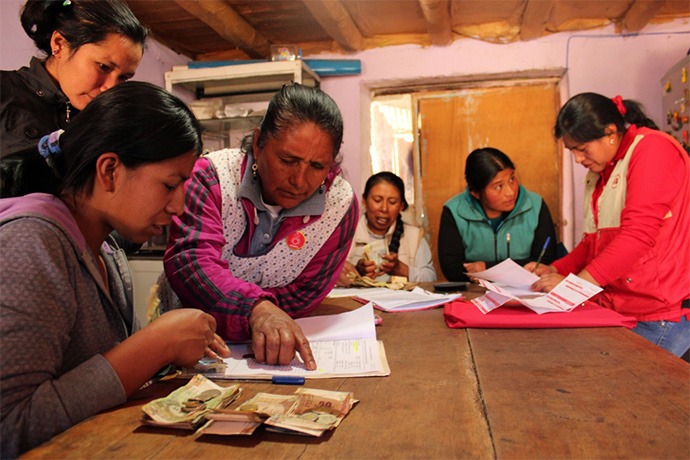
At this village bank meeting in Peru, Pro Mujer staff confer with their clients. Pro Mujer is a development and microfinance institution that issues credit through group-based loans. The organization also provides preventive health education and basic health screening services. Photo courtesy of Global Partnerships.
When economics professor Muhammad Yunus lent $27 to a group of impoverished villagers in Bangladesh in 1974, he ignited a firestorm of excitement in the global development world that would later earn him a Nobel Peace Prize and the title, “Father of Microcredit.” But over the last couple of decades, enthusiasm for microcredit has waned. And although it remains a significant development program, microcredit – and the often used broader term, “microfinance” – is now part of an ever-evolving suite of financial tools designed for the world’s poor.
From the 1980s to the early 2000s, small loans to the world’s poor were heralded as a silver bullet for global poverty. By late 2010, however, international excitement for microcredit had begun to turn critical.
David Roodman – a senior advisor at the Open Philanthropy Project and former senior fellow at the Center for Global Development – wrote in a 2012 opinion piece for the Washington Post that the “proliferation of fast-growing microlenders had made it easy for poor men and women to get in over their heads in hundreds of dollars of debt.” Without credit bureaus to manage over-indebtedness, and with lax banking supervision, some institutions put profits before people, the antithesis of the original vision.
The “zeal for microcredit,” Roodman felt, had blinded many in the industry to the bigger solution – financial services, not just loans, for the poor. These include, for example, savings, insurance and financial literacy classes. “Financial services are like clean water and electricity – they are essential to leading a better life,” says Roodman.
And that’s where the general verdict on microcredit has landed in 2019. Several studies have found fairly consistent “modestly positive, but not transformative, effects.” Although microcredit hasn’t managed to pull millions of people out of poverty, it has – and continues to – play an important part of their everyday lives. Sometimes it’s a safety net for emergencies; sometimes it helps them put food on the table or keep their kids in school; other times it’s the boost they need for a large purchase. Whatever the reason, access to small loans and other financial tools have changed (for the better) how the world’s poor are living from day-to-day.
But development organizations are taking financial inclusion further now, with the hopes that the effects can be truly transformative for the families and businesses of 1.7 billion people around the world who still do not have access to formal financial services. One way organizations are expanding access is through technology.
The Mifos Initiative was born out of the Grameen Foundation when it became apparent that financial empowerment required more than just microcredit. To that end, Mifos launched an open-source platform to help microfinance institutions become “modern and digitally connected providers of financial services to the poor.” But the organization is also working on making sure that digital financial tools are not only available to institutions, but also to end users through an integrated digital payment system.
The introduction of digital payments – mostly through mobile phones – in the developing context has begun to open up many avenues for financial inclusion. Lower transaction costs have made it more viable for banks to serve the poorest of the poor. Digital payments also make it much easier and faster for overseas workers – and aid organizations – to send cash to families in remote areas. Additionally, the ability to audit payment flows digitally can help improve accountability and transparency.
Seeing this and the challenges in financial inclusion at scale, the Bill & Melinda Gates Foundation, through its Financial Services for the Poor program, is expanding the reach of low-cost digital financial services for the poor. Without focusing on a single product or platform, the program works with government and private-sector partners around the world to foster environments that promote the growth of digital financial services and develop systems that work best for each context.
But in many contexts, the poorest of the poor are illiterate and innumerate. This means that in order for them to use digital payments, they need to rely on others for help or they must learn work-arounds that can result in mistakes, such as transferring the wrong amount to the wrong person. The Boma Project has been exploring solutions to those barriers, such as more visually-based tools (e.g. images of cash bills, instead of just numeric values); text-to-speech options; voice recognition for verification and even numeracy training programs.
Mercy Corps is also partnering with Facebook to explore the possibilities of a new global, digital currency as a way to revolutionize financial inclusion. For people living in countries struggling with conflicts, natural disasters and political instability, this new currency – Libra – could offer financial stability as a low-volatility global currency. And as a fully digital currency with low transaction costs, Libra could also make the global cash transfers much cheaper, especially for poor communities that rely heavily on remittances. The blockchain technology on which the currency will be built could also make aid more efficient, transparent, and accountable.
But beyond just giving financially-strapped families better access to financial services, the original vision of microcredit and microfinance was to lift people out of poverty by supporting their microenterprises. Impact investors are now taking that one step further by investing capital in companies and organizations that will generate a positive social or environmental impact along with a financial return.
Global Partnerships uses the term “impact-first investing” to describe how it prioritizes the “highest possible social impact, while seeking to preserve capital with a modest financial return for investors.” The organization uses philanthropic capital to invest in social enterprises in Latin America, the Caribbean, and sub-Saharan Africa that deliver products and services to empower people living in poverty to improve their lives. As of March 2019, Global Partnerships has invested in 135 cumulative social enterprises.
Similarly, large global investment firms like Capria are also supporting positive social and environmental change through impact investments. Capria runs a network of fund managers who back early-growth businesses in emerging markets. Currently, the Capria Network includes 16 fund managers, investing in 37 countries in Africa and the Middle East, South and Southeast Asia, and Latin America. In addition, members of the Capria Network share knowledge and connections with each other to maximize impact, reach and best practices.
But others like Einstein Rising in Africa and Upaya in India take a more hands-on approach with the entrepreneurs they support. Both organizations offer accelerator programs to help entrepreneurs fully develop their companies, then offer investment to select participants. Not only do these businesses improve the lives of the entrepreneurs, they also create thousands of jobs for those on the margins of society.
And that’s exactly the founding idea of microcredit – that a small amount of money can have a compounding positive impact on the life of someone living in poverty. Although the promises of microcredit haven’t panned out exactly as Muhammad Yunus envisioned, they have inspired the development of a host of innovative financial inclusion tools and social enterprise strategies. With all these ideas combined, perhaps one day everyone can emerge from the shadow of poverty.
# # #
The following Global Washington members are working to increase access to financial services and income-generating activities in some of the poorest parts of the world.
3rd Creek Foundation is a private family foundation focused on global poverty alleviation through grant-making and impact investing. More specifically, the foundation supports early stage programs that create sustained economic opportunity and dignity for the ultra poor.
Awamaki teaches women’s artisan cooperatives in the rural Andes how to start and run their own businesses, connecting the cooperatives to markets and providing training in product development and business management. They create alpaca accessories, woven bags, and home goods. Awamaki supports 180 artisans who are lifting their families out of poverty.
Bill & Melinda Gates Foundation
The Bill & Melinda Gates Foundation’s Financial Services for the Poor program aims to play a catalytic role in broadening the reach of robust, open, and low-cost digital payment systems, particularly in poor and rural areas—and expanding the range of services available on these platforms.
Capria is a global impact investment firm managing multiple funds that accelerate the flow of capital to deliver superior returns in emerging markets.
Dalberg is a global group working to build a more inclusive and sustainable world where all people, everywhere, can reach their fullest potential.
Einstein Rising empowers Africa’s social entrepreneurs through its SME business development curriculum and provides access to startup capital. These wealth creators develop for-profit companies that tackle entrenched social and environmental issues without sacrificing the financial bottom line.
Global Partnerships is an impact-first investor, dedicated to expanding opportunity for people living in poverty. For 25 years GP has invested in sustainable solutions that help impoverished people increase their incomes and improve their lives, with core investments in livelihoods, education, health, energy, housing, and sanitation.
Grameen Foundation is a global nonprofit that empowers the poor, especially women, to end poverty and hunger. It creates breakthrough solutions – spanning financial, agricultural and health services – that leverage digital technology and local partner networks to bring people the tools and opportunities they need to help themselves.
Initiative for Global Development
The Initiative for Global Development (IGD) engages and harnesses the power of the private sector to create sustainable growth and alleviate poverty in Africa.
Largesse is a mission-driven business that specializes in curating beautifully presented handmade, eco-conscious and/or fairly-traded corporate gifts. Largesse helps corporate gift buyers find unique solutions for executive gifts, incentive rewards and promotional products that align with and reinforce their brand values. Largesse’s mission is to create sustainable economic opportunities for marginalized and talented artisans across the world by giving them equal access to the global marketplace of corporate buyers.
In times of crisis, Mercy Corps supports people who lack access to financial resources with cash assistance. Last year, Mercy Corps connected more than 1.1 million people (191,000 families) to cash during emergencies, infusing more than $32 million into local economies around the world.
The Mifos Initiative provides education, training, and tools to enable charitable organizations and social enterprises to make financial inclusion more affordable, available, and accessible to the 2.5 billion unbanked poor in the world.
Oikocredit is a worldwide financial cooperative that promotes global justice by empowering disadvantaged people with credit.
Path From Poverty reaches across cultures to transform lives and communities by partnering with women’s groups; empowering and equipping women to break the cycle of poverty and live into their God-given potential, irrespective of their spiritual beliefs.
Upaya’s mission is to create dignified jobs for the poorest of the poor by investing in small businesses in India’s poorest communities. Upaya creates dignified jobs for the poorest of the poor by building scalable businesses with investment and consulting support.
Organization Profile
A Different Kind of Capitalism: Einstein Rising Lifts Up African Social Entrepreneurs
By Amber Cortes
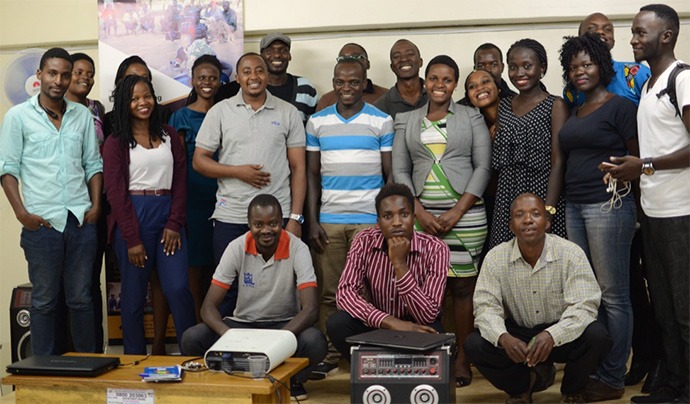
Einstein Rising’s final accelerator cohort of 2018. Photo provided by Einstein Rising.
Einstein Rising is shifting the philanthropic status quo to Africa beyond aid. An ambitious goal, to be sure, but then again, supporting ambitions is what this organization does best.
A Ugandan-based business accelerator for social entrepreneurs, Einstein Rising embraces African solutions to African problems. The founder, Alexis Chavez, developed an approach with her team that focuses on wealth creation with many positive ripple effects on entrenched issues.
Set Up to Succeed
Since 2009 Chavez has worked throughout Africa, starting off in wildlife rescue, then in conservation through humanitarian aid. But she couldn’t shake the feeling that the existing aid mechanisms alone could not combat the root cause of these problems—poverty.
Chavez was living in Bwindi, a UNESCO world heritage site in Uganda, near the border of Rwanda and Congo. It is home to about half the world’s endangered mountain gorillas. “And this is where I started to see the big problem,” she says.
“The NGOs are there, trying to preserve the mountain gorillas, trying to help communities so they, too, will preserve the mountain gorillas. And, as you walk down the street there, it’s—failed aid project, failed aid project, failed aid project.”
The project Chavez ran for a U.S.-based NGO was no different. “People often find my criticism of the traditional aid model quite abrasive,” Chavez says. “Saying, ‘But we were only trying to help,’ from thousands of miles away seems like a reasonable reaction. But on the ground in Africa, it’s people’s lives.”
Chavez expresses frustration with aid models that solely employ direct assistance (donated goods and cash grants or vouchers) or micro-lending to alleviate poverty.
“For us, we don’t want to put a Band-Aid on the situation. I think everyone is exhausted from firefighting these entrenched issues. So, how do we get in front of them? We find the people that know how to solve the problems.”
Isaac is a recent Einstein Rising accelerator graduate whose company sells household toilets (as opposed to communal trench toilets, which can harbor disease and contaminate ground water). The company hauls the waste away and converts it into fertilizer pellets. “I’ve knocked on more organizations’ doorsteps then I can count,” Isasc told Einstein Rising. “They all told me ‘nice idea but we cannot help you.’”
Einstein Rising rose to the challenge, and recently invested $5,000 in Isaac’s company.
A Space to Invest In
Uganda has the largest population of young people in the world—77% of its population is under the age of 30. In 2015, the World Economic Forum ranked Uganda as the world’s most entrepreneurial country, clocking in almost 30% of business-owning adults. But it’s tough for these start-ups to survive. According to a 2014 report from the Global Entrepreneurship Monitor, the biggest challenge that entrepreneurs in Africa face is access to capital.
“Coming in as a business accelerator was really ideal,” Chavez explains, “there are no jobs but there’s also no shortage of young people with impactful ideas. But they need guidance and they need capital.”
Here’s how Einstein Rising works. Entrepreneurs apply to be part of an accelerator program. It is a no-cost model, which provides a three-month business development curriculum. Throughout the process, Einstein Rising offers intensive mentorship, coaching, education, and finance tools, as well as marketing advice — all with the goal of creating long-term value for investors, entrepreneurs, the community, and the environment. After completing the program, entrepreneurs participate in a pitch day where individuals—and NGO’s—can decide whether to fund their vision. After the Einstein Rising board reviews the pitches, the best performing companies receive startup capital investment of between $2,500 and $10,000. Einstein Rising recoups its investments by receiving a 10% dividend on the annual profits of the investments. The goal is complete self-sufficiency.
Africa has countless investment opportunities, Chavez says, yet venture capital needs to be redirected towards SMEs—small to medium enterprises. This is also where financial support can be transferred from traditional aid models. These types of companies require “patient capital,” as they generally have slower returns, but they make up the majority of the African investment sector. This, Chavez says, is where Einstein Rising sees opportunity.
A Different Kind of ROI
At Einstein Rising, success is measured not just by dollars, but by impact and innovation—how a business gives back to its employees, community, and the environment, as well as how a particular problem is tackled.
The businesses that Einstein Rising develops hail from a range of social and environmental justice work: street kids earning a living through recycling, farmers addressing food waste, disadvantaged youth & refugees becoming freelance video producers and film editors.
Almost every company has a unique idea or strategy, and to be considered for investment, the idea must be scalable and replicable. Financial growth, however, doesn’t have to come at a high cost for both people and the planet. For Einstein Rising companies, the more impact they make, the more profitable they become.
Socially conscious capitalism, also known as ‘ethically-grounded free enterprise,’ rests on guiding principles other than just answering to stakeholders, such as cultivating ethical leadership and respecting culture and the environment. Conscious capitalism accepts that most of the world is operating under a powerful economic system, but decides that dollars alone do not have to drive decisions.
The Entrepreneur Revolution
“From the top down, change isn’t happening.” Chavez says. “Or at least, not at a good rate anyway. So how do we do bottom-up change? How do we shift?”
Einstein Rising now has about 125 entrepreneurs going through its accelerator program every year, and has affected over 10,000 people, through direct and indirect impact, over the last few years. The organization is also growing through dozens of partnerships, like the Impact Hub co-working space in Kampala, and with Muhammad Yunus’s microfinancing institution, Grameen Bank. More recently, Einstein Rising is working with Africa’s 4th-ranked Makerere University to run its brand-new entrepreneurship innovation center.
“If we work with social entrepreneurship, and we’re putting people in positions of power who really care about their environment and their community, for us it’s this whole idea of the entrepreneurial revolution, and creating a system, sort of reallocating power.”
The network has already expanded. For every company developed, each entrepreneur creates jobs and impacts lives. This chain reaction has allow Einstein Rising to affect the lives of over 10,000 people within the last four years.
And if the entrepreneurs of the future have a strong sense of social responsibility, Chavez says, “then it’s a really good place to be.”
Goalmaker
“The Advancer” Takes Impact to the Next Level
By Amber Cortes
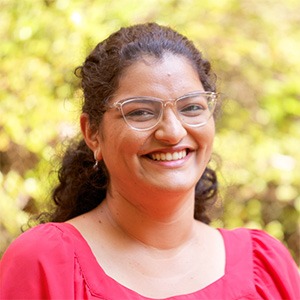 “The Advancer.” It sounds like the code name for a spy in an epic thriller blockbuster film—someone who brings all the mystery and intrigue to the plot. But instead, Uma Sekar solves mysteries—bringing rigorous datasets, illuminating metrics, and evaluative savvy to her role as “The Advancer” for global investment firm, Capria. Sekar develops and manages Capria’s impact strategy—helping fund managers and companies decipher the puzzles of how to make money by being sustainable, and making the world a better place.
“The Advancer.” It sounds like the code name for a spy in an epic thriller blockbuster film—someone who brings all the mystery and intrigue to the plot. But instead, Uma Sekar solves mysteries—bringing rigorous datasets, illuminating metrics, and evaluative savvy to her role as “The Advancer” for global investment firm, Capria. Sekar develops and manages Capria’s impact strategy—helping fund managers and companies decipher the puzzles of how to make money by being sustainable, and making the world a better place.
“We recently changed the title,” she explains. “It always used to be “The Evaluator.” But it’s not just about creating evaluation methods, but actually doing something with them!”
Her official title at Capria is Director of Impact and Fund Manager Advancement, but “The Advancer” just sounds so much more fun. Capria’s model of impact investing is a little different than most—instead of investing directly in companies across the world, Sekar explains, Capria’s network fund identifies fund managers who know their communities and understand the challenges of the local market, “and supports them so that they can make really smart investments that succeed in the long term.”
“My role has been to support them on that journey,” Sekar says, “all the way from defining what their impact thesis is and figuring out what types of investments they’re going to make with an impact lens, to choosing the right company. And once you make the investment, supporting those companies to manage for impact.”
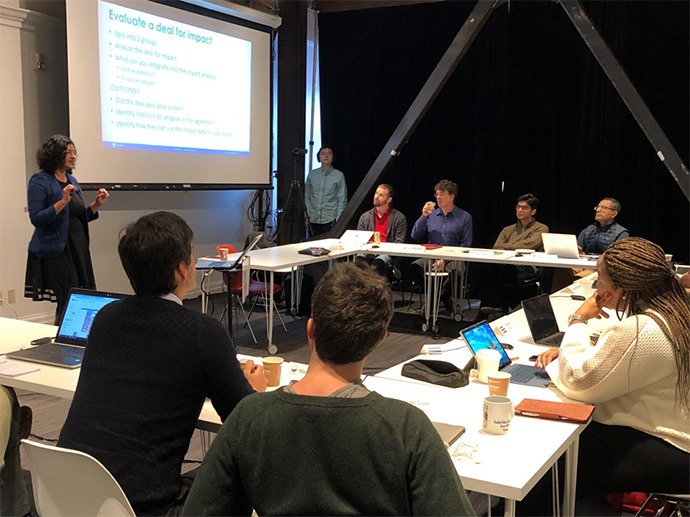
At a group training in Seattle, Uma Sekar trains a group of fund managers on how to evaluate a deal for impact. Photo provided by Sekar.
Sekar helped build out the impact strategy for one of the members of the Capria Network, Unitus Ventures (formerly United Seed Fund), a venture impact fund in India that supports tech-enabled startups working in the healthcare, education, jobs, and finance sectors. At Unitus Ventures, Sekar has collaborated with over thirty CEOs to implement impact management strategies into their business plans.
Capria’s support could mean anything from helping CEOs align their vision with their impact strategy, evaluating best practices for operational support, and collecting the right data to help companies secure more customers and growth capital.
While this may sound like part of the course of any smart business strategy, what makes Sekar’s job unique is advancing the ethical, positive impacts and managing for negative risks of a company. For example, part of her role involves developing Environmental, Social, and Governance (ESG) frameworks for sustainable and responsible investing. ESG performance thresholds help determine how well a company will perform in the long run. But in some cases, finding methods for measuring these kinds of impacts are not always as clear cut as with other bottom-line ROIs.
For example, how do you quantify something like trust? That was the challenge facing Sekar when she worked with one company that wanted to become the “Uber of toktoks.” You may have seen them if you’ve ever been to India—those little human-powered passenger carts called rickshaws, known locally as “toktoks.”
“One of the key issues in terms of impact in my discussion with the CEO, the core reason behind starting this business, was to make sure that people trusted auto rickshaw drivers.” Sekar explains, “and measuring something like this is really hard—there are no explicit metrics for it. And you can’t really develop a psychometric profile on the drivers.”
So instead, they decided to track the number of police complaints on the drivers in the platform from local precincts to see if those were reducing over time. And they also got a customer feedback mechanism built into the app.
“That’s an example of something that’s highly qualitative,” Sekar says. “It’s cultural change that needs to happen and we had to find a way to quantify it, set it into motion, and see how it progressed over time.”
Connecting the CEO’s long-term vision for the company’s impact—to build trust—with their goals of being a successful business, is what an ‘impact strategy’ is about, and it’s a win-win for everybody.
“Their impact strategy is built into how they’re thinking about the business from the beginning. And then it’s identifying metrics that will add enhanced value over time. He knew that if he can solve the trust problem, then more customers will use the app!”
You could say Sekar and Capria are navigating new waters—impact investing is a field that has only been around for the last twelve years. Eventually, Sekar wants to see an ecosystem where prioritizing social and environmental impact is “no longer unique—it’s embedded in what everyone does.” She doesn’t think it’s going to happen in five years, or 10 years. But she does think the right steps are being taken.
Some of these steps include standardizing best practices for impact evaluation and management. Sekar points to a few examples: a set of operating principles developed by the IFC/World Bank, the five dimensions of impact developed by the Impact Management Project, and a study by the Global Impact Investing Network, Core Characteristics of Impact Investing. All of these, Sekar says, add clarity and consistency to an emerging field.
Though the United Nation’s Sustainable Development Goals have provided a set of global goals for impact-aligned institutions to align with, Sekar says that we need to have “a better mechanism of measuring towards those SDGs. It would be great if we knew everyone who’s in the impact investing industry, how everyone’s contributing towards some of those goals; which goals are not being achieved, and where to move capital.”
The impact investing space is growing—according to the Global Impact Investing Network’s Sizing the Impact Investing Market report, the market for global impact investing is now $502 billion. Sekar sees this future as bright, and likes to tap into the next generation of thinkers and doers through her work with Capria, and through her volunteer endeavors with organizations like Young Women Empowered in Seattle.
“I think it’s a very interesting juncture,” Sekar says. “And I think the generational shift is leading that to some extent; with more millennials who want social and environmental impact to be at the core of every business. And we want to put money behind that.”
From Our Blog
Microcredit Can Be a Life-Changer – But It Isn’t for Everyone
By Heather Targosz, Marketing & Communications Manager, Upaya

Employees sort waste at a Saahas Waste Management facility outside Bangalore, India. Photo courtesy of Upaya Social Ventures.
One person in every 10 is living in extreme poverty today, earning less than $1.90 per day. This figure has dropped significantly from 35% in 1990, but the issue remains a top priority of the UN Sustainable Development Goals (SDGs). Eradicating poverty (SDG 1) means finding more innovative, cost effective and scalable ways of reaching the last 10%.
Arguably, one of the more effective solutions to alleviating poverty in the past several decades has been microcredit, in which very small loans are extended to impoverished individuals. Microcredit has proven extremely effective in helping individuals, oftentimes women, become entrepreneurs. Given a microloan, a woman might be able to open a fruit stall at the market or sell handcrafted jewelry out of her home. When used properly, the potential of microcredit is remarkable and life-changing for those in poverty. But not everyone is a fit for microcredit.
Welcome New Members
Please welcome our newest Global Washington members. Take a moment to familiarize yourself with their work and consider opportunities for support and collaboration!
A Child’s Notebook
All children deserve a quality education. A Child’s Notebook partners with local communities and invests in the lives of children in Southeast Asia. achildsnotebook.org
Andrew W. Lyon Travel
Andrew W. Lyon Travel elevates its clients’ travel experience by organizing group logistics, crafting unique experiences, and connecting them to the world. www.andrewwlyon.com
Member Events
September 14: The Rose International Fund for Children // Annual Fundraiser
September 24: World Affairs Council // Giving Meaning to “Never Again”: Preventing Genocide and Crimes Against Humanity
October 6-8: Asheshi // Deep Dive
October 11: Agros // Tierras de Vida
October 22: The Max Foundation // Maximize Life Gala
October 24: Sahar // Annual Fundraiser
November 21: BuildOn // Gala
Career Center
Manager, Global Programs, UW Foster School of Business
Development and Operations Coordinator, Splash
Permanent Supportive Housing Advocate, YWCA of Seattle-King-Snohomish County
Check out the GlobalWA Job Board for the latest openings.
GlobalWA Events
September 13: A Conversation with Feminist Rukhshanda Naz from Pakistan
November 15: GlobalWA Goalmakers Conference